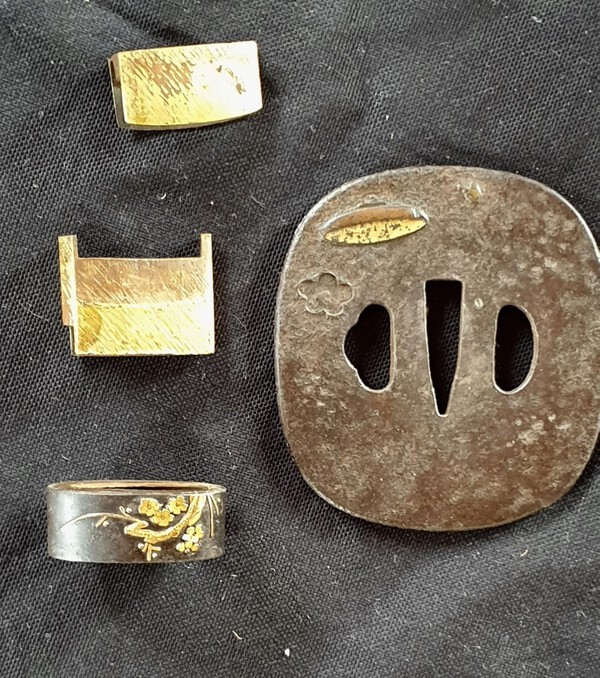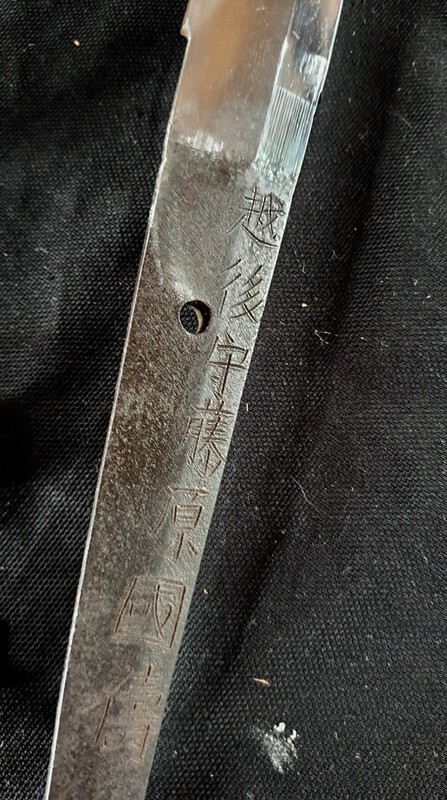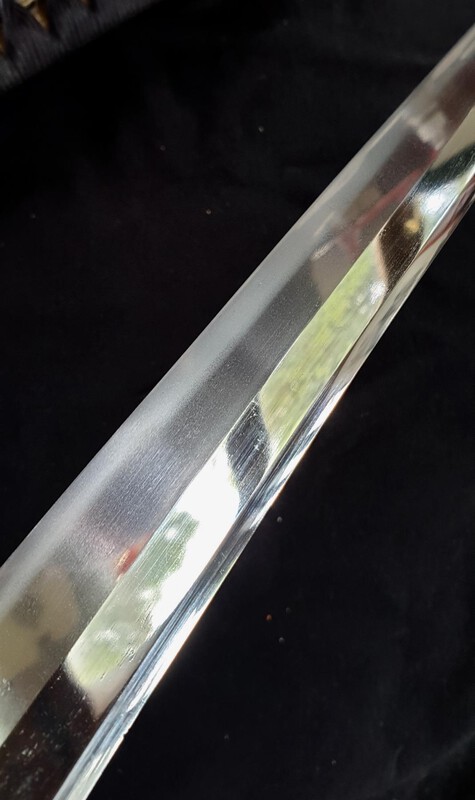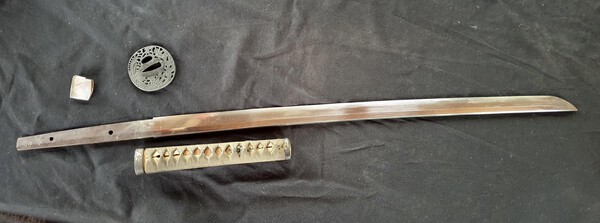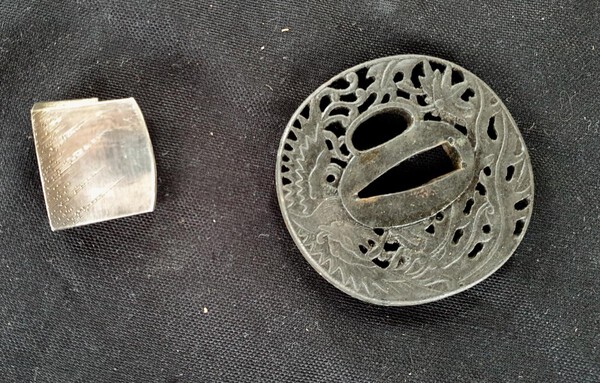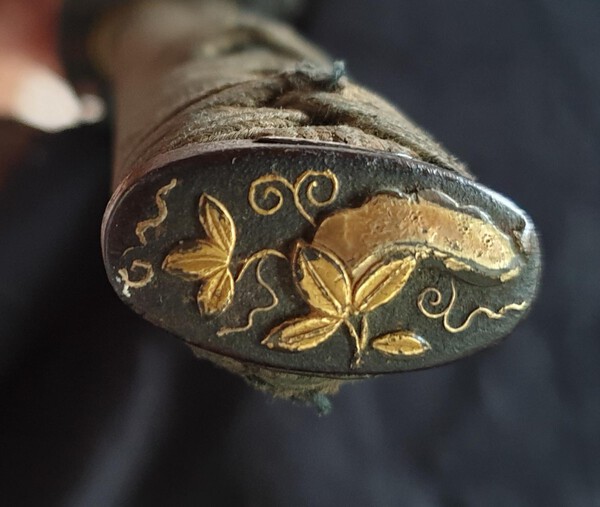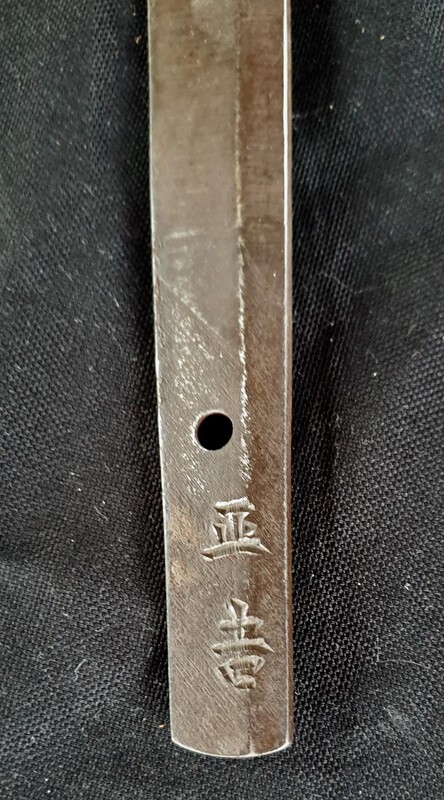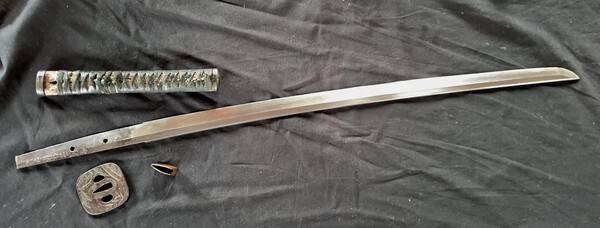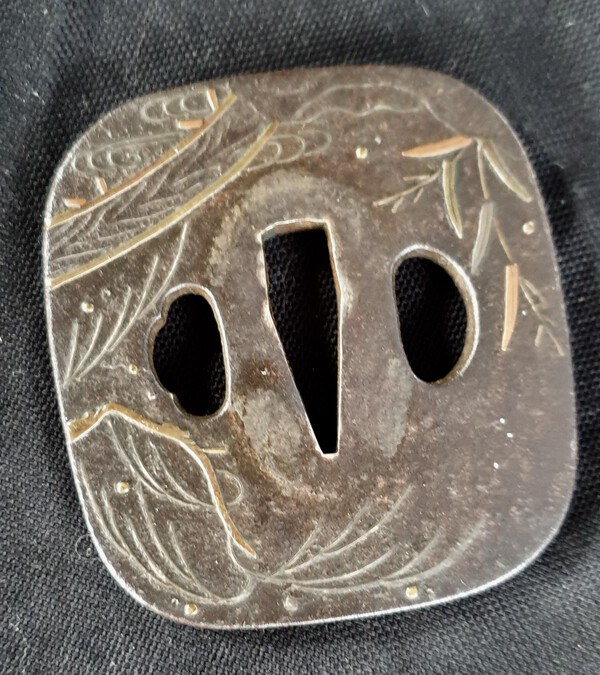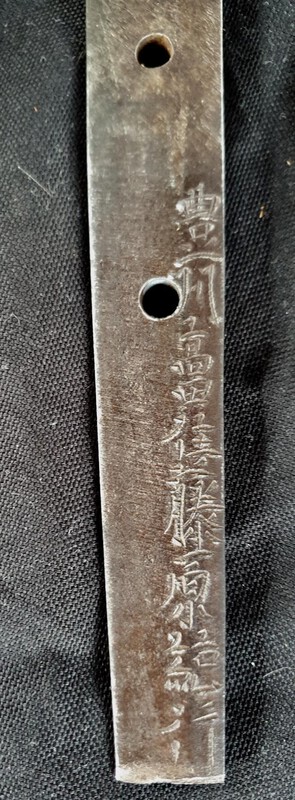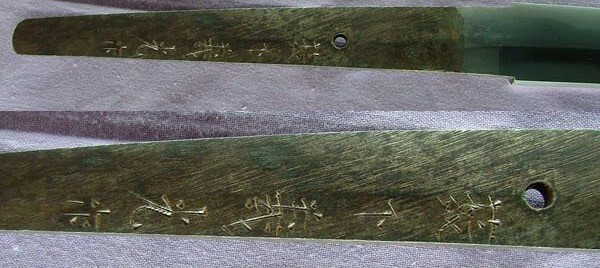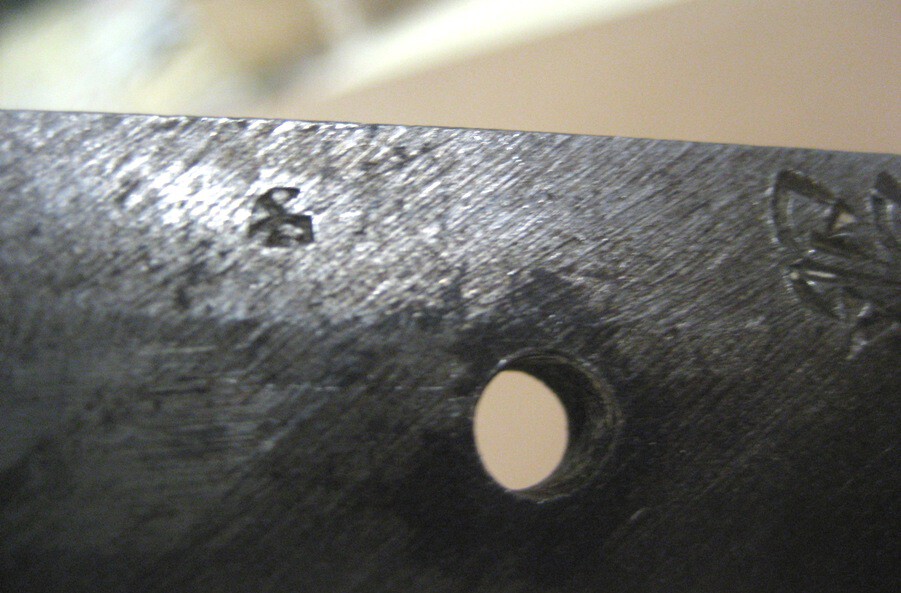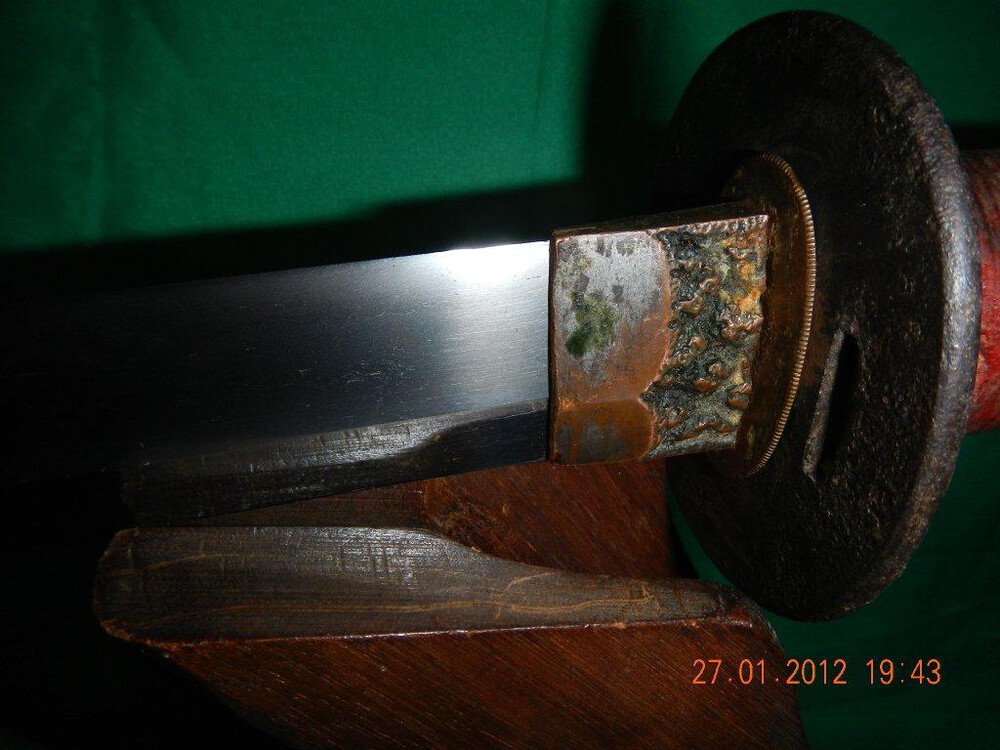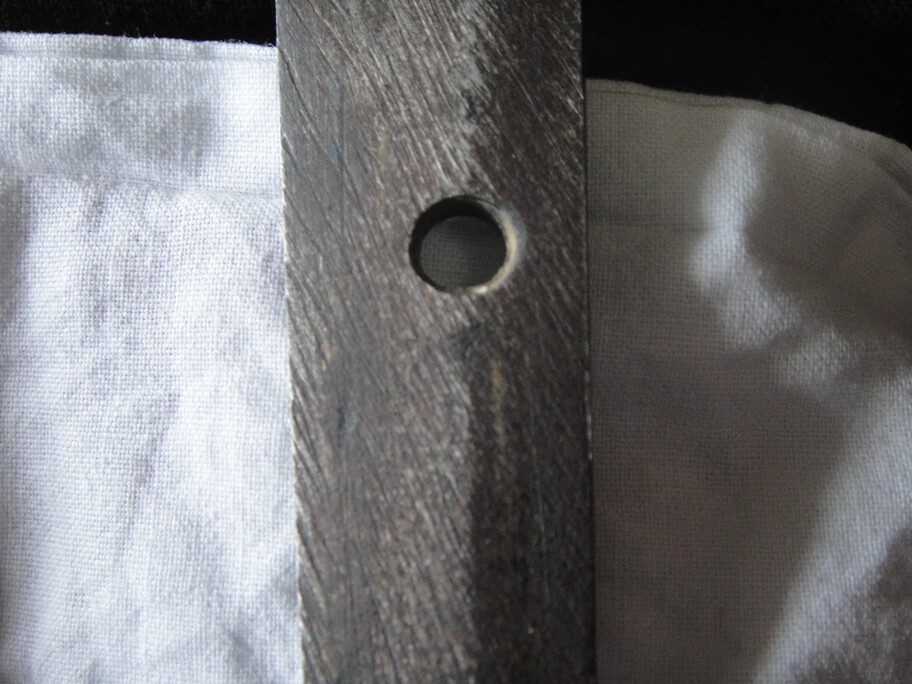-
Posts
79 -
Joined
-
Last visited
Everything posted by Navy
-
Oh yes, my fault. Sword A nagasa 65,2 (cm) kissaki 3,2 motohaba 3,1 Sword B nagasa 63,7 kissaki 4,3 motohaba 3,2 Sword C nagasa 68,5 kissaki 3,8 motohaba 3
-
Thank you very much for your inputs. Yes, all have sayas, and all are made of black laquered wood; none of them is particularly interesting and all have some chipping/missing lacquer at various degree. I cleaned the blades with Kleenex and pharma grade petrol, and then oiled again with choji. Since it is in quite rough polish, I used little uchiko on sword A to try to find out a bit more details and take the pics.
-
Sword C. The better, at least in terms of polish. Visible hada and hamon, 2 pieces gold plated habaki.
-
Sword B. Also in bad polish, but better blade overall condition (no nicks). Again, I wasn't able to discerne the hada. Nice silver habaki.
-
Thanks Geraint! This is the first (let call it sword A): this one should be the oldest, and also the worst in terms of condition/polish. No visible hada, barely visible hamon. Hugly suriage job.
-
Hello to you all. A good friend of mine has a really huge collection of blades, spacing from VI to XX century. Among these, he owns 3 katanas, 1 wakizashi and 1 tanto; all are (or seem to be) nihontos, probably made between XVI and XVIII century: this is the best he can remember, having bought these blades "en block" among other western blades at least 25/30 years ago. He hasn't any record about age, smiths, provenance, etc. If you don't mind, I would submit these blades to your appreciated knowledge for evaluation. Thanks in advance.
-
Hi Denis; if it has already been cleaned, as I think looking at the fuchi (silver traces on the edges and inside the stamps), it is possible to do it without harming the finish. Personally I wouldn't use the grit, try as suggested some chemical products, starting with the less aggressive you have at the hands, and then step up. You're right, that paint is very thick, so good chances the details are still there. Do a first, careful attempt on the bolt (brass mekugi), so you can check how strong is that silver with no risk for original finish or details. It is a matter of find the right stuff, adding a lot of patience.
-
Yes, it has been repainted (look at the sarute and at the stamps on fuchi). As you noticed, under the silver paint there are traces of the original brown coating, but how much of it is still there is a bet. I would try petrol or acetone in a hidden, small spot just to see if it is an easily removable paint. To me, it seems that is has been already partially cleaned (look at the fuchi again).
-
In my opinion, the repaint is a No No: it is like repainting an helmet or reblue a gun, it does affect the originality of the item. Nothing against a light cleaning or working to stop active corrosion: dust, dirt and rust were not original WWII issue.
-
This is why I find so interesting the Japanese WW2 blades: unlike the western sabres (with the rare exception of those issued to cavalry mounted troops), which are essentially uniform/dress adjunct, they were intended to be used in the field, and saw actual, extensive use in every battleground, even in the air!
-
Arigatō gozeimass, useful inputs here. Some more bits to evaluate this sword and decide about it. Thanks again!
-
Dōmo arigatō gentlemen; any chance to have the nagako translated? Is there any stamping showing the date she has been made?
-
Hi to you all; I've already posted this blade, but due the site crash I hadn't the time to read carefully the answers (thanks for those who replied), thus I ask for your help again. This sword is in gunto koshirae type 98, has a nagasa of 67 cm, the smith should be Yoshimitsu and, despite advertised as Taisho blade, the seller defines it as semi-traditional gunto. Due the presence of the "torokusho" license I understand this souldn't be a mass produced, only machine-made blade, am I wrong? Unfortunately I'm not able to read Japanese kanji's, so would someone of you experts be so kind to translate the nakago's writings? Those painted in red are also present on the tsuka. I find this sword interesting, so I'd like to know more about it. Thanks in advance, M.
-
Thanks Chris! May I ask you what the Nagoya arsenal stamp could mean? Did that arsenal make blades besides rifles and bayonets? This nakago lacks seki and showa stamps, and the oshigata hasn't the Kanesane kokuin, just the two smith's kanji. Regards, Marzio
-
Dear collectors, thanks to the informations given by this forum I'm trying to do my homeworks diligently, so I attempted to translate the nakago of this type 3 gunto I'm spotting. If I did it correctly, the smith should be Kanesane, and the production date should be November 1943 (in order from above: Showa era + 18 year (-1) and 11th month); it hasn't the usual seki stamp, but just that one which seems to me a "na" symbol (Nagoya?) Is it right? Regards, Marzio
-
Thanks to you all! Actually, it does have the boshi (as for the togishi words), but for that sum I think it's better to view in person the blade, including the nakago... I don't like too much the fact that it is mumei and reworked in the machi area recently... Marzio Italy
-
Ok collectors, after a couple of days of "investigation", I didn't get the pics of the nakago but I spoke with the togishi which made his job some years ago on that blade: it was heavily rusted, the nakago is mumei with sign of suriage (2 mekugi ana), and both the machi's were milled almost to the same level of the nakago, so he had to work seriously on them (and actually a gap between the mune and the upper corner of the fuchi is well noticeable); in his opinion the blade (by the shape of hamon and sugata) is a good one, possibly a copy of bizen school, made at the end of 1700. Asking price is 2.800... Regards, Marzio
-
... 1700 AC, or XVIII century... I know, no tang, no party, but that red Tsuka? Marzio
-
-
Dear collectors, I spotted this sword in a on-line gunshop and I like to have your opinion on it; it has an unusual WWII koshirae, and that red tsuka ito ; the seller states it is an old blade, made around '700; to my untrained eyes it seems an old blade, fitted with WWII parts; I know you need nakago pics to better evaluate it, but what do you think at a glance? Thanks, Marzio Italy
-
I did it above, I forgot to do it on the last 2 posts. Thanks to you all for your appreciated assistance. Regards, Marzio Italy
-
Mmmm, maybe a "crew gunto" (private order)? But someone is suggesting me the blade had a suriage in the past.
-
Hi KM, I've been told this sword (wakizashi) should be a late Edo/early Meiji period, so a traditional made blade... Did the military arsenals make also mass produced wakizashi during WWII?
-
I tried to get some detailed pics, but I guess I need a better camera... Any comments will be really appreciated, thanks in advance. Marzio Italy
-
Dear collectors, first of all thanks to you all for your previous inputs; the sword is finally arrived so I'm here again with new pics and measures: - nagasa 57,5 cm (roughly 22,63 in; so is it a wakizashi?) - kissaki 3,5 cm (1,37) - nakago (mumei) 18 cm (7,08) - blade height at yokote 2,3 cm (0,90) - blade height at munemachi 2,8 cm (1,10) The hamon (gunome?) is visible but not crisp, and I think there is some hada on the blade. I can't find out the boshi. In the boshi area, to the right side near the ha there is a kizu Other than this, the sword seems quite healthy. Marzio Italy




